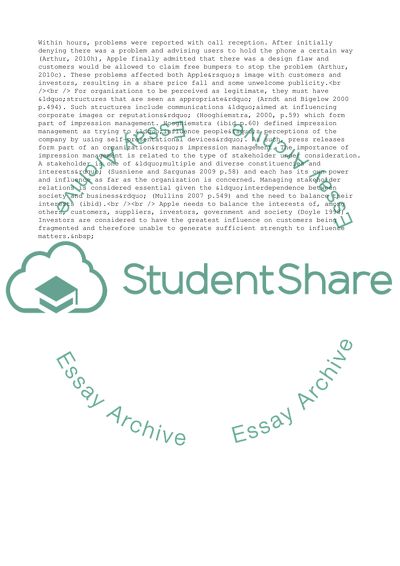Cite this document
(An Analysis of Apples iPhone 4 Problems Using Stakeholder Management Case Study, n.d.)
An Analysis of Apples iPhone 4 Problems Using Stakeholder Management Case Study. Retrieved from https://studentshare.org/business/1574385-identify-an-organisational-crisis-eg-an-accident-a-product-safetyhealth-hazard-or-a-scandal-and-investigate-how-the-organisation-reacted-to-by-means-of-information-releases-eg-press-releases-annual-report-corporate-social-responsibility-repo
An Analysis of Apples iPhone 4 Problems Using Stakeholder Management Case Study. Retrieved from https://studentshare.org/business/1574385-identify-an-organisational-crisis-eg-an-accident-a-product-safetyhealth-hazard-or-a-scandal-and-investigate-how-the-organisation-reacted-to-by-means-of-information-releases-eg-press-releases-annual-report-corporate-social-responsibility-repo
(An Analysis of Apples IPhone 4 Problems Using Stakeholder Management Case Study)
An Analysis of Apples IPhone 4 Problems Using Stakeholder Management Case Study. https://studentshare.org/business/1574385-identify-an-organisational-crisis-eg-an-accident-a-product-safetyhealth-hazard-or-a-scandal-and-investigate-how-the-organisation-reacted-to-by-means-of-information-releases-eg-press-releases-annual-report-corporate-social-responsibility-repo.
An Analysis of Apples IPhone 4 Problems Using Stakeholder Management Case Study. https://studentshare.org/business/1574385-identify-an-organisational-crisis-eg-an-accident-a-product-safetyhealth-hazard-or-a-scandal-and-investigate-how-the-organisation-reacted-to-by-means-of-information-releases-eg-press-releases-annual-report-corporate-social-responsibility-repo.
“An Analysis of Apples IPhone 4 Problems Using Stakeholder Management Case Study”, n.d. https://studentshare.org/business/1574385-identify-an-organisational-crisis-eg-an-accident-a-product-safetyhealth-hazard-or-a-scandal-and-investigate-how-the-organisation-reacted-to-by-means-of-information-releases-eg-press-releases-annual-report-corporate-social-responsibility-repo.


